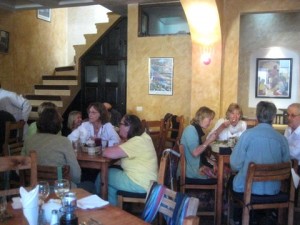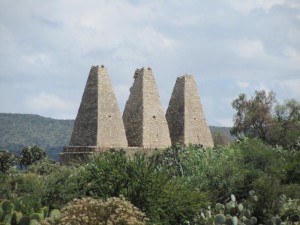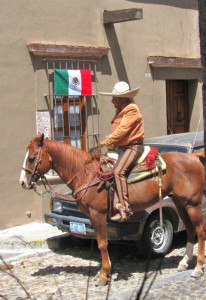Barriers & Boys
July 31st, 2016Recently, I received a request to partake in an interview about women chefs in San Miguel. I wasn’t going to be included in the hot chef list—that seemed to be reserved for women under 40. Instead, I was going to be featured as a maestra–a teacher, a role model, a woman who opened the doors for the next generation.
My first reaction was, “Geez, how old do you think I am?” In my mind, the doors had already been flung open. I was the fortunate one that grew up in a world where I honestly believed I could do anything. I admired and appreciated the struggle of the many women before me, some even before my mother and grandmother. Their actions and sacrifices gave me my absolute freedom.
But that’s America, at least my experience in America. This is Mexico.
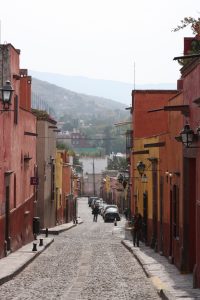
Jesus Street
My second reaction to the interview request—“Really? Foraging a path for women? Me?” I sat back and reflected on the early days and soon felt the weight of how hard it had been. That moment was the first time I realized that I had indeed fought the fight. And then, I started to cry, amazed that someone had noticed my struggle and was curious about it.
When I opened my café in 1991, San Miguel was a quiet, conservative and extremely traditional town. I, unbeknownst to myself at the time, had chosen to infiltrate the provincial Latino world of Ozzie and Harriet, thinking that the fringe of expat hippies would soften the blow—it didn’t.
Since gender had never been an issue nor a hindrance in my life, it didn’t occur to me that it could become one. Well, at least not until the coffee vendor arrived.
I had just opened my café and marveled when a man bearing coffee beans and a price list showed up on my doorstep. He said hello and asked to speak with my husband. I replied that I didn’t have one. He then asked to speak with my father. “He lives in Texas,” I answered, somewhat confused.
“Well, who am I suppose to talk to?” he questioned, anxiously.
When I told him that I was the owner, he grabbed his samples and stomped out exclaiming, “I’m not going to discuss business with a woman!”
I don’t remember being angry. Well, maybe a little, but it was more my style to laugh and think, what an idiot. Someone else would gladly accept my tainted girl money.
Then there was the waiter I told to do something on his second or third day of work. He replied, “I don’t take orders from women.” Needless to say, that was his last day of working for a mere female.
For years after that, I mostly hired single mothers, more intelligent beings whose top priority wasn’t ego, but feeding and educating their children. They were more than happy to take orders from me —they had had enough of men telling them what to do.
Truth be told, my introduction to this new world of injustice and inequality actually came at the very beginning, when I first applied for a Mexican work permit. At the time, the head of immigration interviewed me, took my filled-out forms and passport, and put them in his top desk drawer.
I was told to check back the following week. When I did, I was escorted to the Jefe’s office where he closed the door and pulled out my passport. Leafing through the pages, he said, “Meet me tonight.” I said I couldn’t. “Then come back next week. I can’t help you now.”
This routine went on for 6 months. As I watched other foreigners collect their FM3s, I was always asked to wait–the Jefe wanted to see me. Because of my limited life experience at the age of 25, I actually believed that one day he’d give up and my new, shiny immigration booklet would be waiting for me. What were my options anyway? I didn’t have money for a lawyer, nor a family in Mexico to support my cause. Local government officials? I knew not to waste my time.
I rented a space on Jesús and was making plans to finally open my café, painting the walls and pricing furniture, when I started to panic– optimism and patience were getting me nowhere. I needed help, so I found a lawyer who would intervene. He went to Mexico City and over the head of our local immigration office. He got my work permit as well as my passport back, but it took every cent I had to pay for it—all the money I had saved to open my café was gone. I had to take out (another) loan in order to continue with my dream as well as look for a paying job, in addition to working full time at the café.
Knowing of my predicament and wanting to help, a respected middle-aged businessman asked me to tutor his 12-year old son in English. He praised my intelligence and hard work and told me to come to his office—not their home—for the first lesson. I was grateful for the extra money and agreed. When I showed up, the child was nowhere in sight, only the father, who proposed yet another job, one that would make me even more money—if I would put on the lingerie he had spread across his desk and allow him to take pictures.
“Just for me,” he said, “No one else has to know.”
Seriously? SERIOUSLY!!
How many women before me had to suffer through a similar scenario in order to make my life, at least until then, void of this ridiculousness?
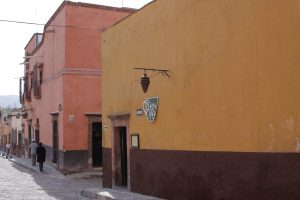
There was also another issue at hand, one that caught me somewhat by surprise—class discrimination. In the Mexico I arrived to, women of a certain class didn’t work, and especially not in a kitchen—that was the realm of servants. Due to my skin color and education I was of that class, even though culturally I was far removed. Early on, I learned that not many of my male peers respected my work or my effort. They thought I was playing a game until I could find a husband.
A “high-bred” Mexico City man, a potential suitor, who I knew socially, stopped by the café one day. When I appeared, my apron smeared with flour and chocolate, he exclaimed with disgust, “You cook?” He never really spoke to me again.
A few others made it clear that if our relationship were to go any further that I would have to renounce my embarrassing, unladylike habit of working in a kitchen. I would be allowed to own the café, and even supervise its day-to-day business, however it would be unacceptable to do actual labor. I would not be allowed to cook…or sweat. (I swear, one of them actually said sweat, and then had a ceiling fan installed in my kitchen, so he would never find me with a wet brow.)
The men came and went, but my café, my work in the kitchen remained. I got my hands dirty and even, god forbid, washed a few dishes. Did I set an example to young Mexican women from “good families” that it was ok to work in a kitchen? That it was ok to do what you wanted, not what your husband or family expected you to do? Honestly, I think what changed the game was the new era of the celebrity chef and the popularity of the cooking channel.
Luckily, things did get easier with time—I also got older and wiser and tougher. And even though I still suffered years of not being taken seriously and was talked down to by men, much less educated than myself, I persevered. Gaining respect in the community took time, but it happened, or at least I think it did. I had to fight for that respect, though, the same respect that would have been handed to a man, no questions asked.
I’ve been at the helm of my business as a sole female proprietor for 25 years. Until very recently, there were only a few of us female chefs and restaurateurs in town, but this is changing, and changing fast.
If you consider my story of struggle opening doors for the next generation of women, then please, save me a seat at the table with the other maestras.
**So, you’re wondering what happened to the Jefe, huh?? Well, the next time he played his game with another young American woman, he forgot to thoroughly read her papers. If he had, he would have noted that she had just married into a prominent local family. This family took him down. They did the job that I couldn’t…but maybe, just maybe, my original complaint made firing him an open and shut case.

